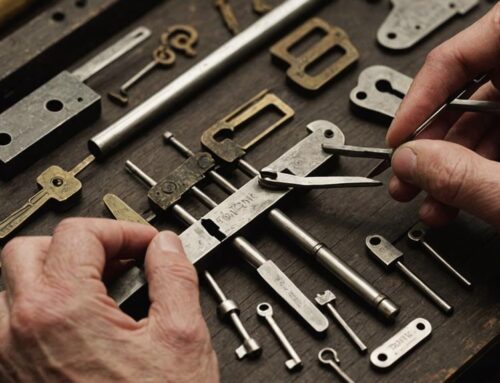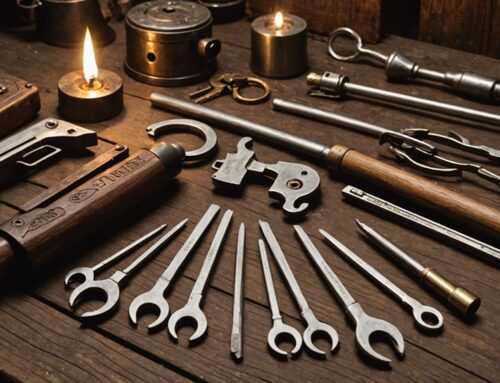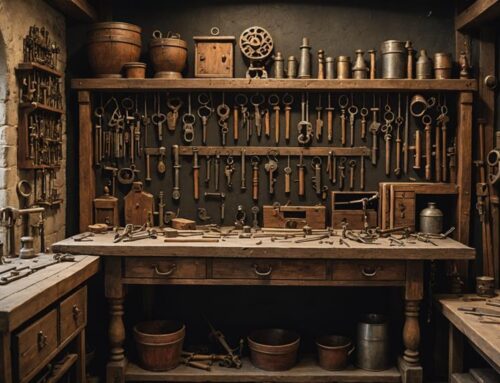Discover the fascinating journey of lock picking evolution, ranging from ancient Egyptians using wooden pins to Mesopotamian and Greek advancements with metal locks and picks. In medieval times, tools like tension wrenches and warded picks were key in manipulating locks with finesse. Through early modern innovations and the Industrial Revolution, locksmithing saw a surge in efficiency and precision. Specialized military lock pick sets emerged, shaping strategies for intelligence operations. Today, electronic lock pickers and advanced training programs reflect the ever-changing landscape of lock picking techniques. The future promises biometrics integration and AI advancements, emphasizing the need for continuous innovation in security measures.
Key Takeaways
- Ancient civilizations used wooden and metal tools for lock manipulation.
- Medieval locksmiths employed picks and tension wrenches for finesse.
- Early modern innovations introduced specialized tools for lever tumbler locks.
- Industrial Revolution advancements led to complex, mass-produced locks.
- Military and modern eras saw the development of high-tech electronic and non-destructive entry tools.
Ancient Lock Picking Methods

When delving into the domain of ancient lock picking methods, it becomes evident that the ingenuity of our predecessors knew no bounds. Ancient lock picking techniques date back centuries, showcasing the resourcefulness of ancient civilizations in overcoming security measures.
The ancient Egyptians, for example, used wooden pins and key-shaped tools to manipulate simple wooden bolt locks, reflecting their advanced understanding of mechanical design and security. In Mesopotamia, around 4000 years ago, early locksmiths devised intricate designs for locks and keys, some of which required a level of skill to pick, illustrating the sophistication of their craftsmanship and the importance of security in their society the art of ancient lock-picking.
The Greeks and Romans also contributed to the evolution of ancient lock picking methods. They crafted locks made of metal and employed tools such as picks and tension wrenches to manipulate them.
These techniques laid the foundation for modern lock picking methods, emphasizing the importance of precision and patience in the craft. Studying ancient lock picking methods not only provides insight into the history of security systems but also highlights the timeless art of manipulating locks and keys.
Medieval Lock Picking Techniques

Let's talk about Medieval lock picking techniques.
During this time, lockpickers used a variety of tools, such as picks and tension wrenches, to manipulate locks. These tools were often crafted with great precision, reflecting the skills of medieval locksmiths who understood the intricacies of their designs.
The techniques developed in the Middle Ages laid the foundation for modern lockpicking methods, as they incorporated principles of mechanical manipulation and security that can still be seen today in the art of medieval locksmithing.
Medieval Lockpicking Tools
To explore the domain of Medieval lock picking techniques, one must first acquaint themselves with the rudimentary tools utilized during that era.
In the sphere of medieval locksmithing, lock picks were simple yet effective tools. The most common pick was the "warded pick," designed to manipulate the wards inside a lock to align the tumblers correctly. These picks were typically handcrafted by skilled locksmiths and were made from durable materials like iron or steel.
Another essential tool in a medieval lock picker's arsenal was the "tension wrench." This tool was used to apply slight pressure to the lock's inner mechanisms while the pick manipulated the tumblers.
By combining the use of the warded pick and tension wrench, medieval lock pickers were able to finesse their way through various locks.
Despite their simplicity, these medieval lock picking tools were vital for those skilled in the art of locksmithing. Their effectiveness lay in the precision and patience required to navigate the intricate mechanisms of locks during that time.
Techniques in Middle Ages
Exploring the techniques employed during the Middle Ages for lock picking reveals a fascinating blend of skill and ingenuity.
Historic lockpicking techniques from this era were often rudimentary compared to modern methods but required a deep understanding of locks and mechanisms. One common approach was the "raking" method, where a pick with multiple notches was inserted into the keyway and jiggled until the pins set. This technique was based on trial and error but could be effective with practice.
Another technique used in the Middle Ages was the "impressioning" method, where a blank key was inserted into the lock and manipulated until it left marks indicating the correct pin positions. This process was time-consuming but often successful in opening locks without the original key.
Lockpicking during the Middle Ages demanded patience, dexterity, and a keen eye for detail.
These historic lockpicking techniques paved the way for the development of more sophisticated methods in the centuries that followed.
Early Modern Locksmith Tools
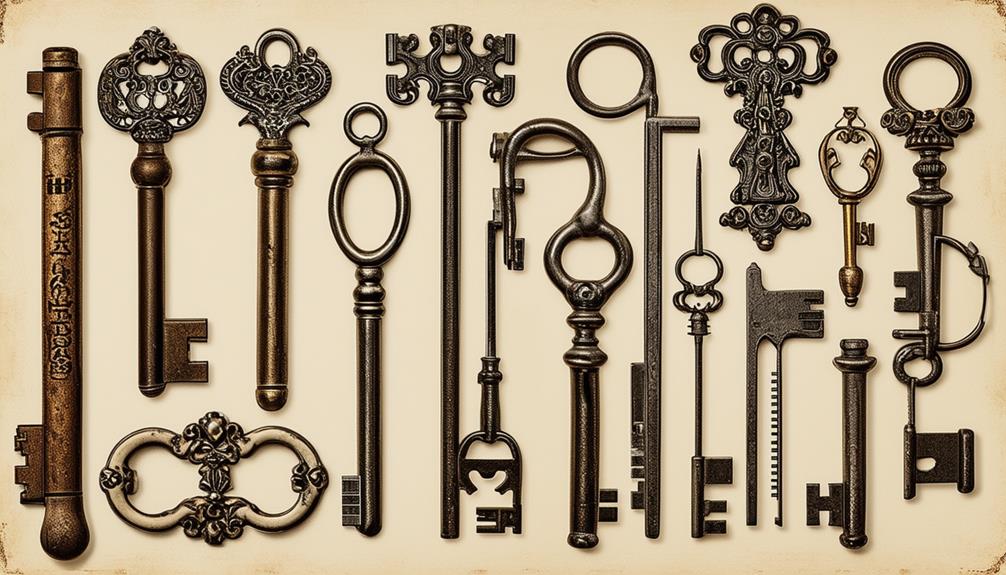
Early modern locksmith tools revolutionized the craft of lock picking, paving the way for more sophisticated techniques and designs. During the historic locksmithing period, locksmiths primarily used tools such as picks, tension wrenches, and rakes.
However, in the early modern era, advancements in metallurgy allowed for the creation of more durable and precise tools, leading to a significant improvement in lock picking efficiency. The evolution of lock picking tools throughout history highlights the innovative spirit of locksmiths and their response to increasingly complex locking mechanisms the evolution of lock picking tools.
One significant tool that emerged during this time was the lever tumbler lock. This type of lock required a specialized tool known as a lever lock pick to manipulate its internal components effectively. The lever lock pick had a slender design with a curved tip, allowing locksmiths to lift individual levers to the correct height to open the mechanism.
Additionally, the development of key-turners made it easier for locksmiths to rotate the key in the lock cylinder, aiding in the lock picking process. These tools, along with improved key-making techniques, marked a pivotal moment in the history of lock picking, setting the stage for further innovations during the Industrial Revolution.
Industrial Revolution Innovations
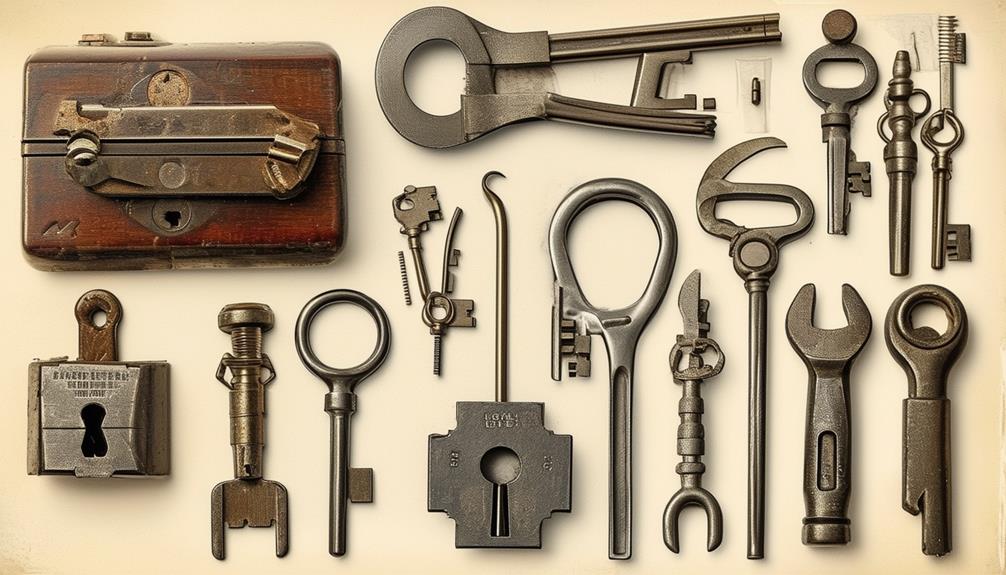
Now, let's shift our focus to the Industrial Revolution period and the innovations that revolutionized locksmith tools.
During this time, advancements such as interchangeable parts and mass production techniques greatly influenced the evolution of locksmith tools.
These innovations not only improved the efficiency and precision of lock picking tools but also paved the way for the development of more secure locking mechanisms, reflecting the broader changes in the landscape of lock security.
The overall impact of these advancements had a significant effect on the overall security measures implemented during that era.
Locksmith Tool Evolution
During the Industrial Revolution, locksmith tools underwent significant advancements and innovations that revolutionized the trade. The history of locksmith tools is rich with developments that shaped the profession into what it's today.
Here are some key points to help you understand the evolution of locksmith tools during the Industrial Revolution:
- Introduction of Machine-Made Tools: The Industrial Revolution saw the shift from handmade to machine-made locksmith tools, increasing efficiency and consistency in production.
- Development of Key Machines: Key cutting machines were invented during this period, allowing locksmiths to create precise duplicate keys quickly.
- Advancements in Lock Picking Tools: Improved lock picking tools, such as picks and tension wrenches, were designed to be more effective and user-friendly.
- Standardization of Lock Components: Standardized lock components made it easier for locksmiths to work on different locks, promoting interchangeability.
- Invention of Combination Locks: The Industrial Revolution also brought about the invention of combination locks, adding a new dimension to locksmithing techniques.
These innovations not only streamlined the locksmith trade but also laid the foundation for modern locksmithing practices.
Impact on Security
Locksmith tool advancements during the Industrial Revolution not only transformed the profession but also had a lasting impact on security measures. Innovations in historical lock mechanisms led to the development of more sophisticated locks that were harder to pick. The introduction of new manufacturing techniques allowed for the mass production of locks, making them more affordable and widely accessible.
These advancements in lock technology forced locksmiths to adapt their skills and tools to keep up with the changing security landscape. Lock picking techniques that once worked on older, simpler locks became obsolete, prompting the need for new approaches and tools to bypass these improved security measures.
As a result, the Industrial Revolution innovations in locksmithing not only raised the bar for security but also increased the demand for skilled locksmiths who could navigate the complexities of these new locks. This shift in the locksmithing landscape highlighted the essential role that historical lock mechanisms played in shaping modern security practices.
World War Era Advancements
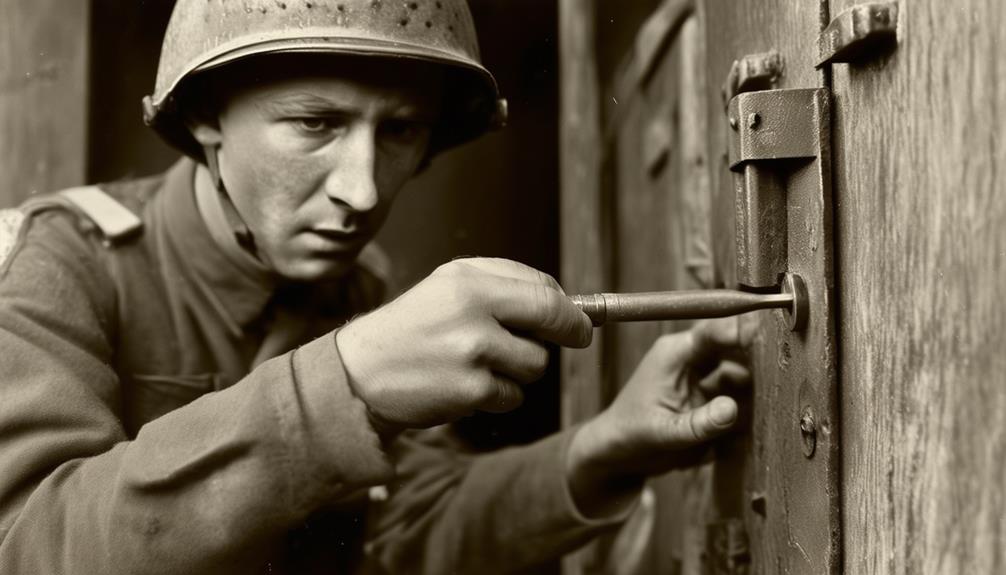
Amidst the tumultuous World War era, advancements in lock picking techniques and tools flourished, driven by the urgent need for covert entry and espionage activities.
Lock picking became an essential skill for intelligence agents and resistance groups seeking access to restricted areas, prompting discussions about the legality of such practices in various regions, as illustrated in lock picking regulations.
Here are some key developments from that era:
- Specialized Tools: Lock pick sets were designed specifically for military use, featuring compact designs for easy concealment.
- Training Programs: Military organizations implemented rigorous training programs to educate operatives on lock picking techniques.
- Improved Lock Designs: Lock manufacturers developed more complex mechanisms to counter espionage efforts, leading to advancements in lock picking methods.
- Innovative Techniques: Operatives devised new strategies such as impressioning and decoding to bypass sophisticated locks.
- Stealth Entry: Lock picking played an important role in enabling silent and swift entries, essential for successful intelligence operations.
These advancements during the World War era laid the foundation for modern lock picking techniques and tools, shaping the future of covert entry and espionage activities.
Modern Electronic Lock Pickers

In the domain of lock picking today, the landscape has been greatly influenced by the rise of modern electronic lock pickers. These devices have revolutionized the history of lock picking by offering a high-tech alternative to traditional methods.
Modern electronic lock pickers utilize innovative technology to bypass security mechanisms quickly and efficiently, often incorporating features such as essential tools designed for precision and effectiveness. They often feature automated functions that can decipher complex locking systems with ease, making them a popular choice among locksmiths and security professionals.
Unlike manual lock picking tools that require skill and practice, electronic lock pickers operate using advanced algorithms and digital interfaces. These tools have become indispensable in the field, allowing for faster access to various types of locks.
While some purists argue that electronic lock pickers take away from the artistry and finesse of traditional lock picking, their effectiveness and speed can't be denied in the modern world.
Contemporary Lock Picking Trends
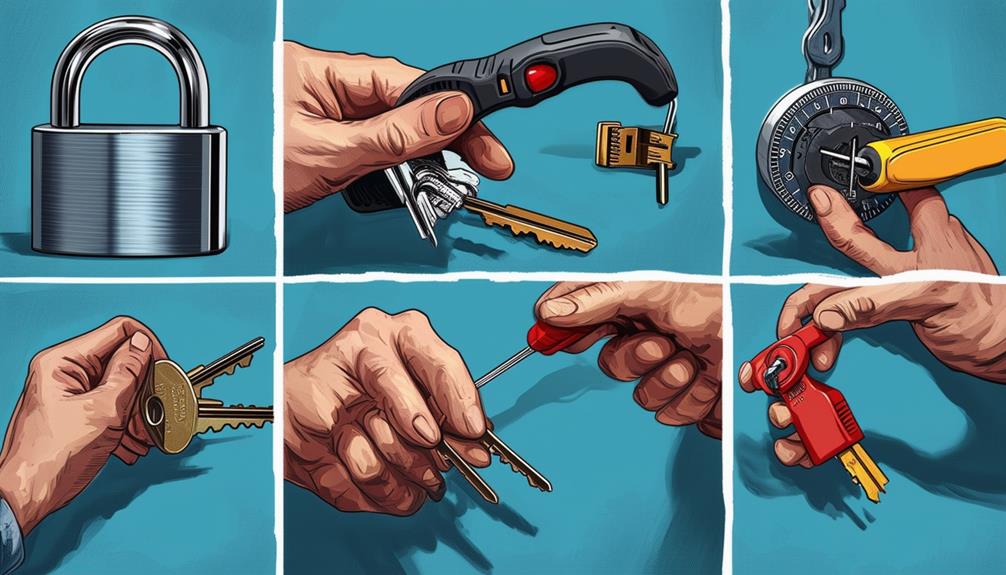
With the increasing advancements in security technology, contemporary lock picking trends have adapted to meet the challenges posed by sophisticated locking mechanisms.
As professional locksmiths seek to enhance their skills, they're exploring advanced lock picking techniques that cater to modern security systems.
Lock picking techniques have evolved in response to these advancements. Here are some key trends to keep in mind:
- Specialized Tools: Lock pickers now use highly specialized tools designed for specific types of locks, enhancing precision and efficiency.
- Digital Lock Picking: As more locks incorporate digital components, lock pickers have developed techniques to bypass electronic security features.
- Non-Destructive Entry: Lock pickers are focusing on techniques that allow for entry without causing damage to the lock or door, emphasizing stealth and reusability.
- Advanced Training: Lock pickers are investing in advanced training programs to master complex techniques and stay ahead of new security measures.
- Community Collaboration: Online forums and workshops facilitate knowledge-sharing among lock pickers, fostering a collaborative environment for learning and innovation.
Future of Lock Picking Technology

As lock picking technology continues to evolve, the future holds exciting prospects for advancements in bypassing security measures. The future of lock picking technology is poised to revolutionize the way we approach security systems. Innovations in biometrics, artificial intelligence, and smart locks are shaping the landscape of lock picking.
| Advancement | Description | Impact |
|---|---|---|
| Biometrics Integration | Incorporating fingerprint or retina scans into lock systems | Enhances security by adding unique, personal identifiers |
| AI Algorithms | Developing algorithms to analyze and exploit lock vulnerabilities | Speeds up the lock picking process by automating tasks |
| Smart Lock Integration | Utilizing IoT technology to control locks remotely | Increases convenience but may introduce new vulnerabilities |
These advancements highlight the dynamic nature of lock picking technology, emphasizing the need for constant innovation in security measures. The future of lock picking technology is not only about bypassing locks but also about enhancing security protocols to stay one step ahead of potential threats.
Frequently Asked Questions
How Has Lock Picking Influenced Popular Culture?
Lock picking has impacted popular culture by appearing in movies, TV shows, and video games.
It's often portrayed as a skill used by spies, detectives, or even burglars. This portrayal has added an air of mystery and intrigue to lock picking, making it seem like a cool and secretive ability.
As a result, many people have become curious about the art of lock picking and its techniques.
Are There Any Famous Historical Figures Known for Lock Picking?
Yes, there are famous historical figures known for lock picking.
Individuals like Harry Houdini and Eugene Francois Vidocq were skilled in this art. Their expertise in lock picking not only helped them in their professions but also added an intriguing element to their public personas.
These figures demonstrated the finesse and ingenuity required in the practice of lock picking, making them stand out in history for their unique abilities.
What Are the Legal Implications of Lock Picking?
When it comes to the legal side of lock picking, it's essential to know that laws vary by location.
In many places, possessing lock picking tools with the intent to use them unlawfully is illegal.
Even if your intentions are innocent, being caught with these tools can lead to serious consequences.
It's best to educate yourself on the specific laws in your area to guarantee you stay on the right side of the legal system.
Can Lock Picking Skills Be Used for Ethical Purposes?
Sure, lock picking skills can definitely be used for ethical purposes.
For instance, locksmiths use these skills to help people who are locked out of their homes or cars. Additionally, security professionals may employ lock picking techniques to test the strength of locks and improve security systems.
As long as these skills are used responsibly and legally, they can serve valuable purposes in enhancing security and assisting individuals in need.
How Has Lock Picking Evolved in Different Regions Globally?
Lock picking has evolved uniquely across regions globally.
Different techniques and tools have emerged based on cultural influences and technological advancements.
Understanding these diverse approaches can broaden your perspective on the art of lock picking.
By exploring these variations, you can appreciate the complexities and nuances that have shaped this skill worldwide.
Embrace the diversity of lock picking evolution and open up a world of knowledge in this fascinating field.
Conclusion
So, now that you've explored the fascinating world of lock picking history, you're practically a master locksmith! With ancient techniques, medieval tricks, and modern technology at your fingertips, you're basically a lock-picking wizard. The future of lock picking is looking bright, and who knows, maybe you'll be the next lock picking prodigy to revolutionize the industry! Keep practicing and who knows what amazing locks you'll be able to conquer next.



